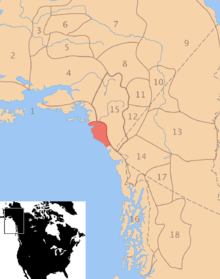Eyak people
The Eyak (Eyak: ʔi·ya·ɢdəlahɢəyu·, literally "inhabitants of Eyak Village at Mile 6"[2]) are a Native American indigenous group historically located on the Copper River Delta and near the town of Cordova, Alaska. Today, Eyak people live in Cordova, Yakutat, and across Alaska and the U.S. Many of them do not qualify to be tribal members in the Native Village of Eyak, a federally recognized Alaska Native tribe established through the Alaska Native Claims Settlement Act in 1971, due to the enrollment qualifications that extend tribal membership only to be those who reside in the town of Cordova, Alaska for the majority of the year.
 Pre-contact distribution of Eyak | |
| Regions with significant populations | |
|---|---|
| 428[1] | |
| Languages | |
| English, Eyak (before 2008) | |
| Religion | |
| Christianity | |
| Related ethnic groups | |
| Tlingit, Ahtna, Chugach Sugpiaq | |
Territory
The Eyak's territory reached from present day Cordova east to the Martin River and north to Miles Glacier.
There were four main villages:
- Alaganik, near Mile 21 of the present day Copper River Highway
- Eyak, located near Mile 5.5
- unnamed, 800 yards south of Eyak
- Orca, located within present day Cordova
In addition to these villages the Eyak would seasonally occupy fish camps at Point Whitshed and Mountain Slough.[3]
History
The Eyak initially moved out of the interior down the Copper River to the coast. There they harvested the rich salmon fishing grounds. When the Russians arrived they recognized the Eyak as a distinct culture and described their territory on their maps. They also traded with the Eyak and sent them missionaries. Because of their small population, they were often raided and their territory boundaries were under pressure from the Chugach to the west. The Tlingit, on the east side, had better relations with the Eyak and this led to intermarriage and assimilation of many Eyak. This pushed the Eyak's territorial boundary further west and contributed to the Eyak's decline. When the Americans arrived they started canneries and competed with the Eyak for salmon. This combined with integration with, and novel diseases introduced by non-native settlers led to the further decline of the Eyak. As populations decreased the remaining Eyak began to congregate near the village of Orca.[4] In 1880 the population of the village of Alaganik was recorded at 117 and by 1890 it had declined to 48.[5] In 1900 total population was estimated at 60. As more settlers arrived this last village became the town of Cordova. As of 1996, there were 120 living, partial Eyak descendants.[4] The last full-blood Eyak, Marie Smith Jones, died on January 21, 2008.[6]
Language
The Eyak spoke a distinct language closely related to the Athabaskan languages. Pressure from neighboring ethnic groups and the spread of English resulted in a decline of the Eyak language. Marie Smith Jones (1918–2008) was the last native speaker. Michael Krauss is known first and foremost as an Eyak language specialist.
Shamanism
Eyak Shamans used drums or painted wooden figures of humans, mammals, and other animals that were made powerful when in the shamans’ possession. These objects were used to heal, foretell the future, prevent evil spirits, grant fertility, and/or travel into the spirit realm.
Notable Eyak people
- Marie Smith Jones, last fluent speaker of traditional Eyak language
References
- Eyak Corporation
- Krauss, Michael E. 1970. Eyak dictionary. University of Alaska and Massachusetts Institute of Technology 1963-1970
- "Eyak Native History". Cordova Historical Society. Retrieved 26 February 2010.
- Campbell, L.J. (1996). "Native Cultures in Alaska". Alaska Geographic. Anchorage, Alaska: The Alaska Geographic Society. 23 (2): 70–73. ISSN 0361-1353.
- Hodge, Frederick (1912). Handbook of American Indians North of Mexico: A-M. Government Print Office. Retrieved February 25, 2010.
- Holton, Gary (1 February 2010). "Overview of the Eyak Language". University of Alaska Fairbanks. Retrieved 26 February 2010.
Further reading
- Birket-Smith, K., & De Laguna, F. (1938). The Eyak Indians of the Copper River Delta, Alaska. København: Levin & Munksgaard, E. Munksgaard.
- De Laguna, F. (1990). "Eyak." In Handbook of North American Indians, Vol. 7 Northwest Coast. W. Suttles, ed. Pp. 189–96. Washington D.C.: Smithsonian Institution Press.
- Harry, A. N., & Krauss, M. E. (1982). In honor of Eyak: The art of Anna Nelson Harry. Fairbanks, Alaska: Alaska Native Language Center, University of Alaska.
- Hund, Andrew. "Eyak." 2004. Encyclopedia of the Arctic. Taylor and Francis Publications. ISBN 1-57958-436-5
- Hund, Andrew. 2008. "’Old Man Dude’ and Eyak Shamanism" Alaska Historical Society ~ University of Alaska's Statehood Conference, Alaska Visionaries: Seekers, Leaders, and Dreamers. Anchorage, AK. Unpublished manuscript.